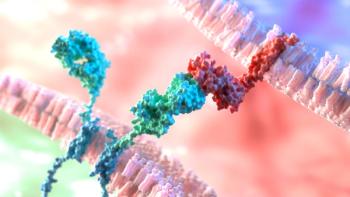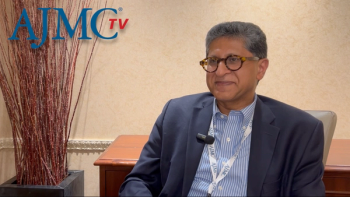
- August 2024
- Volume 30
- Issue 9
- Pages: SP678
In Value-Based Cancer Care, “Personalization Is Thriving, Standardization Is Trying to Keep Up”
Part of the Institute for Value-Based Medicine series, the June 20, 2024, event was presented with Banner MD Anderson in Phoenix, Arizona.
How can health systems balance personalization in cancer care, which tailors treatment to the individual, with standardization, which adheres to treatments and procedures shown to have the best outcomes?
That was one of the challenges discussed June 20, 2024, at the second annual Advancing Value-Based Oncology event, presented by Banner MD Anderson in Phoenix, Arizona, in partnership with The American Journal of Managed Care®, part of the Institute for Value-Based Medicine series.
Cochairs Michael Choti, MD, MBA, chief of surgery, Banner MD Anderson, and Robert Groves, MD, executive vice president and chief medical officer, Banner Aetna, kicked the event off by recognizing the complexity of oncology, value-based care, and integrating these systems in an efficient way.
A Call for Value-Based Oncology for Older Patients
Sindhuja Kadambi, MD, assistant professor, Department of Medicine, Wilmot Cancer Institute and University of Rochester Medical Center, spoke to the benefits of incorporating geriatric oncology into value-based care models when addressing the needs of older adults with cancer.
Bias constitutes a primary concern for the aging population. When one thinks about a “geriatric” patient, a frail person experiencing several health issues may come to mind. Although a substantial heterogeneity exists among older adults based on their health statuses, cognitive performances, and abilities to perform daily activities, Kadambi posited that chronological age typically informs an oncologist’s treatment decisions.
She described how age-related bias puts patients at risk. A clinician may assume the fitness level of a younger patient from the aging population and prescribe a perceivably manageable treatment course. This assumption could lead to overtreatment and result in more harm than good because a patient’s physiological state may not reflect their chronological age. Conversely, older patients on the spectrum may be perceived as frailer, leading to undertreatment if a clinician does not offer chemotherapy, for example, due to concerns that it would not be well tolerated at an advanced age.
Older adults with cancer experience significantly higher incidences of geriatric syndromes and comorbidities than those without cancer (P < .001).1 They are more likely to have cognitive impairments, hearing or vision loss, mood disorders, physical impairments, or injuries from falls. Additionally, they tend to have less social support as they age. These factors negatively impact cancer outcomes, leading to increased symptom burden, adverse events related to treatment, functional decline, and overall morbidity and mortality.2-4
“Older adults represent a growing cancer population, and yet they’re disproportionately represented in our FDA registration and [National Cancer Institute]–sponsored clinical trials,” Kadambi continued. She pointed out that even trials that include older adults tend to enroll “fit” participants, which devalues the data; medications and therapies have not been adequately tested in those with additional health issues.
Geriatric patients are often evaluated using measures like the Eastern Cooperative Oncology Group (ECOG) Performance Status Scale; however, implementing methods for objective assessments outside of ECOG performance is an integral component of value-based oncology. Kadambi took this time to strongly promote the use of geriatric assessments. This tool systematically considers multiple domains of a patient’s health, including social support, nutrition, physical and psychological status, and more, to inform treatment steps.
What Kadambi and others have found is that geriatric assessments can accurately detect impairments,5 predict and reduce chemotherapy toxicity risks,6,7 and significantly reduce the number of emergency department visits and unplanned hospitalizations (P < .05).8 The broader application of these assessments, and ventures to minimize the resources they require and showcase their cost-effectiveness, remain a priority moving forward, Kadambi stated.
The evidenced capacity for geriatric assessments to inform treatment decisions, assist with supportive care, improve outcomes, and reduce hospitalizations demonstrates their ability to improve patient- and medical system–related costs. These validated outcomes, Kadambi concluded, exemplify how aging patients could benefit from value-based care. However, she emphasized, more representation in clinical trials is crucial for providing the best care to this population.
The State of Value-Based Oncology in the US
Matthew Callister, MD, senior physician executive at Banner MD Anderson Cancer Centers, overviewed the pressing challenges that have impeded quality and value-based cancer care over the last decade. Unresolved problems surrounding personalized medicine, care resource prioritization, faith in singular care models, and “implicit persuasion” in oncology, he argued, must be confronted to make meaningful differences in patients’ lives.
“I would argue that personalization is thriving, and standardization is trying to keep up,” Callister began. He praised the plethora of treatment options afforded to patients today; however, the proliferation of new medications combined with lacking resolutions in medical literature, clinical trials, molecular and other testing, etc, have complicated efforts to standardize medical practice. Driving this point home, Callister referenced the standard treatment(s) for patients with distal esophageal cancer: adjuvant chemotherapy, adjuvant chemoradiotherapy, or observation. “How crazy this is, we’re this far into studying this disease, which is not rare, and we can’t even narrow what would be the most appropriate?” he said.
Callister also emphasized the need to consider which parameters are not being optimized in oncology. While optimizing drugs has been a priority, he contended that “time to treatment” should become an emphasized parameter in patient care. As a previous analysisindicated, even a 4-week delay of treatment for breast cancer could result in 10 in 1000 patients passing away unnecessarily.9
“One model cannot solve the problems we are trying to solve,” Callister continued, adding that the cancer continuum is vast, incorporating every organ system and nearly every medical specialty. Episode-based or oncology care models factor in valuable resources and outcomes, but, Callister posed, aspects of the continuum such as risk, diagnosis, planning, follow-up care, etc, may lend themselves to different models. Incorporating multiple models to work toward value-based solutions would tremendously benefit the care patients receive.
As his presentation ended, Callister touched on overvalued and futile care, and the “rampant” persuasive tendencies in oncology to question whether patients are truly informed about the benefits of certain treatments. For example, he presented data on the overall survival benefit after breast cancer surgery. These data included 12,000 patients and found that this treatment benefited only 3%. While this treatment could be worthwhile for some, he questioned whether patients are always informed about longevity outcomes, additional costs, or the added emotional distress that can accompany these regimens—especially since 97% of patients do not receive benefit.10
Callister also discussed a recent study assessing chemotherapy use in a patient’s final 15 days of life, which found that aggressive chemotherapy for those with advanced stage disease did not impact survival outcomes.11 “We need to think about splitting the paradigm of how we manage active disease patients into those [who] are truly newly diagnosed first line…vs what I would call advanced disease oncology,” Callister said. Because advanced disease oncology is really a management of personalization, he advocated for stricter standardization measures in molecular testing and recurring/independent validation for care goals, performance status, prognosis and longevity measures, and more.
He concluded: “The biggest question that I always have in my mind for each [care] episode is, ‘Did the episode even need to take place in the first place? Did the patient even need to go on to an episode?’ And that’s the area of oncology I don’t think we’re taking on.”
References
1. Mohile SG, Fan L, Reeve E, et al. Association of cancer with geriatric syndromes in older Medicare beneficiaries. J Clin Oncol. 2011;29(11):1458-1464. doi:10.1200/JCO.2010.31.6695
2. Mohile SG, Bylow K, Dale W, et al. A pilot study of the vulnerable elders survey-13 compared with the comprehensive geriatric assessment for identifying disability in older patients with prostate cancer who receive androgen ablation. Cancer. 2007;109(4):802-810. doi:10.1002/cncr.22495
3. Bylow K, Dale W, Mustian K, et al. Falls and physical performance deficits in older patients with prostate cancer undergoing androgen deprivation therapy. Urology. 2008;72(2):422-427. doi:10.1016/j.urology.2008.03.032
4. Kadambi S, Loh KP, Dunne R, et al. Older adults with cancer and their caregivers—current landscape and future directions for clinical care. Nat Rev Clin Oncol. 2020;17(12):742-755. doi:10.1038/s41571-020-0421-z
5. Jolly TA, Deal AM, Mariano C, et al. A randomized trial of real-time geriatric assessment reporting in nonelectively hospitalized older adults with cancer. Oncologist. 2020;25(6):488-496. doi:10.1634/theoncologist.2019-0581
6. Extermann M, Boler I, Reich RR, et al. Predicting the risk of chemotherapy toxicity in older patients: the Chemotherapy Risk Assessment Scale for High-Age Patients (CRASH) score. Cancer. 2012;118(13):3377-3386. doi:10.1002/cncr.26646
7. Mohile SG, Mohamed MR, Xu H, et al. Evaluation of geriatric assessment and management on the toxic effects of cancer treatment (GAP70+): a cluster-randomised study. Lancet. 2021;398(10314):1894-1904. doi:10.1016/S0140-6736(21)01789-X
8. Soo WK, King M, Pope A, et al. Integrated geriatric assessment and treatment (INTEGERATE) in older people with cancer planned for systemic anticancer therapy. J Clin Oncol. 2020;38(suppl 15):12011. doi:10.1200/JCO.2020.38.15_suppl.12011
9. Hanna TP, King WD, Thibodeau S, et al. Mortality due to cancer treatment delay: systematic review and meta-analysis. BMJ. 2020;371:m4087. doi:10.1136/bmj.m4087
10. Early Breast Cancer Trialists’ Collaborative Group (EBCTCG). Radiotherapy to regional nodes in early breast cancer: an individual patient data meta-analysis of 14324 women in 16 trials. Lancet. 2023;402(10416):1991-2003. doi:10.1016/S0140-6736(23)01082-6
11. Canavan ME, Wang X, Ascha MS, et al. Systemic anticancer therapy and overall survival in patients with very advanced solid tumors. JAMA Oncol. 2024:e241129. doi:10.1001/jamaoncol.2024.1129
Articles in this issue
over 1 year ago
Building a Virtual Model for Care After Cancerover 1 year ago
August 2024 Health Equity Newsover 1 year ago
Biosimilars and Employers: Strategies for SuccessNewsletter
Stay ahead of policy, cost, and value—subscribe to AJMC for expert insights at the intersection of clinical care and health economics.









































